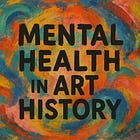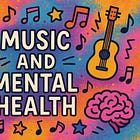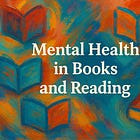Do We Create From the Ill or the Healthy Part of Ourselves?
What Ten Artists Across Time and Culture Teach Us About Resistance, Fragility, and Freedom
While watching the short video above that explores the relationship between creativity, knowledge, and neurosis, I began to think about the binary language of wellness. The speaker argued that mental illness is not the wellspring of art but rather an obstacle to it. This asks the question: do we create from the part of ourselves that is “ill,” or from the part that illness has not managed to capture? But does it even make sense to divide ourselves this way?
The Trap of Division
The language we use to talk about creativity and health is never neutral. To describe an artist as “mentally ill” or to celebrate their “mad genius” is to reinforce a binary: the assumption that health and illness exist as separate, opposing categories, and that creativity can be neatly assigned to one side or the other. But lived experience rarely works this way.
For a long time I have used the phrase “mental health challenges,” which seemed like a softer, more humane alternative to “mental illness.” Yet even this phrase sets up a contrast between the “healthy” norm and the “challenged” exception. More recently, I have leaned toward speaking simply of “health.” This is because our states of mind are not easily divisible. They shift with time, circumstance, and context. What feels like strength one day can feel like fragility the next. A person’s inner life is never fully “ill” or fully “well.” It is a continuum, often changing moment to moment.
Dividing the self into “ill” and “healthy” parts creates certain traps. On one side, it can encourage the romantic idea that art comes directly from illness, that without struggle there would be no creativity. This belief can feel empowering at times but also dangerous, because it risks tying one’s identity as an artist to suffering itself. On the other side, division can suggest that creativity is only possible when one is “well,” denying the reality that art can emerge even when a person feels at their lowest. Both framings miss the truth that the human mind is never static.
There is also a cultural trap here. The way society talks about illness and health influences how artists see themselves. If an artist internalizes the idea that their creativity is bound to illness, they may fear recovery will silence their voice. If they are told that illness obstructs creativity, they may discount the value of work produced in difficult times. In both cases, division creates unnecessary barriers to seeing the full complexity of what creativity actually is: a process shaped by many different states of being, none of which define the whole.
When I think of “health” in relation to art, I don’t imagine a stable condition, free from struggle. Instead, I think of health as the ongoing ability to keep expressing, to keep turning experience into form. Even the parts of us that feel fractured or constrained can contribute to that process. Perhaps the more useful question is not whether art comes from illness or health, but how the shifting balance between the two shapes what gets made.

Creation as Resistance
If Vincent van Gogh is always the first name invoked in conversations about art and madness, Edvard Munch is often the close second. This is likely because The Scream has become so famous that it eclipses the rest of his work. But The Scream is not a standalone piece, it is part of Munch’s larger Frieze of Life series, which explores themes of love, anxiety, and death. Seen in that context, The Scream is less a solitary cry of madness and more one movement in a broader meditation on human existence.
Munch himself rejected the idea that his art was “sick.” He wrote, “When I paint sickness and suffering, they are, on the contrary, a healthy resource.” This statement can be read as more than a simple defense of his reputation. It suggests that Munch was aware of the temptation to see his creativity as inseparable from his psychological struggles, and that he resisted that framing. For him, painting was not the voice of illness but the voice of what illness had not destroyed. His canvases became evidence that even when part of him was trapped by anxiety and melancholy, another part remained free enough to transform anguish into form. In this light, his work testifies to the complex interplay of what we might call the “ill” and “healthy” parts of the self, while also questioning whether such a division can ever be clear.
Frida Kahlo also embodied this stance but in a more visual way. In The Broken Column (1944), she painted herself with a split torso, her spine replaced by a crumbling pillar, her body pierced with nails. Yet despite the brutality of the image, Kahlo’s gaze is steady, direct, almost confrontational. She refuses pity. The work is not merely a reflection of pain but an act of defiance, declaring her subjectivity unbroken even when her body was.
To speak of creation as resistance is to recognize its active quality. Art does not simply emerge out of suffering like steam from boiling water. It requires choice, effort, and shaping. It is the transformation of experience into something communicable, something that insists on its place in the world. This act of shaping is itself an act of health, because it demonstrates that even when life constrains us, something in us refuses to be reduced to silence. Creativity is not passive expression, it is struggle made visible. It is the refusal to collapse completely into what would otherwise consume us.
Altered States and New Perceptions
Some artists reveal how struggle changes perception, and how those shifts become sources of artistic innovation. Rather than treating illness or fragility as an interruption, these works show how altered states can open new ways of seeing, hearing, and feeling. That itself could arguably be an aspect of health.
Virginia Woolf, in On Being Ill, described the strange distortions of perception that come with sickness: the way ordinary life feels uncanny, the way words seem inadequate. Her novels, particularly Mrs Dalloway and The Waves, reflect this perception through fluid, fragmented forms of narration. The fractured experience of illness became a literary method, a way of representing consciousness in flux.
In Indian classical music, Tansen’s ragas acknowledged emotional states as integral to art, not as disruptions. Each raga is tied to moods and times of day, affirming that mind and body are inseparable from music. His work shows how altered states, including melancholy, can deepen expression rather than diminish it.
When we pay attention to altered states, we see how what disturbs or unsettles can also generate innovation. They force us to perceive differently, to find new forms that can hold the dissonance of experience. Art, then, is not just a reflection of these states but a way of metabolizing them into meaning. This is one of the great paradoxes of creativity: the very conditions that seem to narrow life can sometimes expand expression.
Fragility and Form
Other artists show us that fragility itself can become structure. Their work demonstrates that fracture does not need to be hidden, it can be given form and coherence through art.
Robert Schumann’s Geistervariationen hover between coherence and collapse, embodying both lyrical beauty and breakdown.
Yayoi Kusama transforms hallucinations into mirrored rooms of infinite reflection, turning private overwhelm into shared wonder.
Chéri Samba paints boldly about illness and stigma, making vulnerability visible in bright colors that resist shame.
In each case, fragility is not erased. It is shaped into form. This shaping is what makes it bearable, perceptible, even beautiful. Fragility becomes not the opposite of health but one of its textures.
Vulnerability as Testimony
Some artists take this further by making vulnerability itself their subject. Kendrick Lamar writes openly about anxiety and despair, turning them into testimony that resonates with millions. Tracey Emin’s My Bed stages the aftermath of depression without disguise, showing unwashed sheets, bottles, and cigarette butts. Both works insist that what is often hidden deserves visibility.
But is all art vulnerability? In one sense, yes. To create is to expose a part of oneself to the world, to risk being seen. Even the most abstract or playful art contains this element of risk. Yet there is a difference between vulnerability as byproduct and vulnerability as intention. Emin and Lamar make it explicit, demanding that their fragility be acknowledged. Others, like Munch or Schumann, embed it more subtly in form and tone. What unites them is the courage to allow something of the self, fractured, fragile, resilient, to appear.
Perhaps this is what makes art so powerful: it gives vulnerability a place in public life. It turns private struggle into shared experience. It says, “This too is part of being human.”
Creating as Expansion of Health
So do we create from the “ill” part of ourselves, or from the healthy part? The question itself is so misleading. Art is neither a symptom nor a sign of transcendence. It is a process, a way of metabolizing experience, whether joyful or painful, into something that can be shared. To create is to enlarge the space of health, even when beginning from struggle.
How artists interpret this is as varied as the artists themselves:
Munch insisted that even sickness and suffering could become a resource, not a sickness in themselves.
Kahlo showed that pain could be given form without being glorified.
Woolf demonstrated how altered perception might reshape literature.
Schumann’s late works revealed how music can hover between fracture and coherence.
Kusama transformed hallucinations into immersive environments that captivate the senses.
Lamar turned vulnerability into lyrical force, creating space for survival and hope.
Emin laid bare the debris of crisis and insisted on its validity as art.
Tansen’s ragas suggested that altered states could become channels of transcendence.
Samba reminded us that illness and resilience are inseparable, and that art can make both visible at once.
What matters is not locating the precise source of creativity within the self, but recognizing that through art, we create more room for freedom. In the act of shaping experience into expression, we strengthen the parts of ourselves that remain alive, responsive, and capable of transformation. This, perhaps, is the truest definition of health.
I explore the ways art and health intersect using my unique 6-part framework. If you are interested in understanding this in your own life: Order a Creative Health Assessment or Book a 1:1 Coaching Call.





